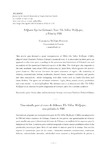Mostrar o rexistro simple do ítem
A Queer Eye for Gilman’s Text: The Yellow Wallpaper, a Film by PBS
| dc.contributor.author | Núñez-Puente, Carolina | |
| dc.date.accessioned | 2024-01-16T08:46:19Z | |
| dc.date.available | 2024-01-16T08:46:19Z | |
| dc.date.issued | 2019 | |
| dc.identifier.citation | Núñez-Puente, Carolina. A Queer Eye for Gilman’s Text: The Yellow Wallpaper, a Film by PBS. Atlantis: Journal of the Spanish Association of Anglo-American Studies, vol. 41, n. 1, 2019, pp. 11-29. https://doi.org/10.28914/Atlantis-2019-41.1.01 | es_ES |
| dc.identifier.issn | 1989-6840e | |
| dc.identifier.issn | 0210-6124 | |
| dc.identifier.uri | http://hdl.handle.net/2183/34916 | |
| dc.description.abstract | [Abstract] This article puts forward a queer interpretation of PBS’s The Yellow Wallpaper (1989), adapted from Charlotte Perkins Gilman’s canonical story. It is structured in three parts: an approach to the term queer, a reading of the queerness (and feminism) of Gilman’s text and an analysis of the queer (and feminist) aspects of the film. The third part also responds to the only academic essay about PBS’s production, by Janet Beer, which ignores the movie’s queer character. This section discusses the queer treatment of topics—the instability of identity, autoeroticism, lesbian tendencies, mental illness, women’s solidarity, and gender and class inequalities—while dialoguing with film critics such as Linda Hutcheon and Laura Mulvey. The queer use of formal resources—light, shots, sound, music, symbolism and scene-motifs—is also highlighted. My ultimate aim is to demonstrate that The Yellow Wallpaper is an innovative queer adaptation of Gilman’s piece for a modern audience. | es_ES |
| dc.description.abstract | [Resumen] Este artículo propone una interpretación queer de The Yellow Wallpaper (1989), una adaptación de PBS del relato canónico de Gilman. Consta de tres partes: una aproximación al término queer, una lectura queer (y feminista) del texto de Gilman y un análisis de los aspectos queer (y feministas) del film. La tercera parte también responde al único ensayo académico sobre dicha producción, escrito por Janet Beer, el cual omite el carácter queer de la misma. Esta sección explora el tratamiento queer de los temas—identidad inestable, autoerotismo, tendencias lésbicas, enfermedades mentales, solidaridad entre mujeres y desigualdades de género y clase—a la vez que dialoga con críticas de cine como Linda Hutcheon y Laura Mulvey. Se señala además el uso queer de los recursos formales—luz, planos, sonido, música, simbolismo y motivos escénicos. Mi objetivo principal es demostrar que The Yellow Wallpaper es una innovadora adaptación queer de la obra de Gilman para un público moderno. | es_ES |
| dc.description.sponsorship | Ministerio de Ciencia, Eduación y Universidades; FFI2017-84555-C2-2-P | es_ES |
| dc.language.iso | eng | es_ES |
| dc.publisher | The Spanish Association of Anglo-American Studies (AEDEAN) | es_ES |
| dc.relation.uri | https://doi.org/10.28914/Atlantis-2019-41.1.01 | es_ES |
| dc.rights | Atribución-NoComercial-CompartirIgual 4.0 International | es_ES |
| dc.rights.uri | http://creativecommons.org/licenses/by-nc-sa/3.0/es/ | * |
| dc.subject | Queer theory | es_ES |
| dc.subject | Film studies | es_ES |
| dc.subject | Feminist literary criticism | es_ES |
| dc.subject | Charlotte Perkins Gilman | es_ES |
| dc.subject | Teoría queer | es_ES |
| dc.subject | Estudios de cine | es_ES |
| dc.subject | Crítica literaria feminista | es_ES |
| dc.title | A Queer Eye for Gilman’s Text: The Yellow Wallpaper, a Film by PBS | es_ES |
| dc.title.alternative | Una mirada queer al texto de Gilman: The Yellow Wallpaper, una película de PBS | es_ES |
| dc.type | info:eu-repo/semantics/article | es_ES |
| dc.rights.access | info:eu-repo/semantics/openAccess | es_ES |
| UDC.journalTitle | Atlantis. Revista de la Asociación Española de Estudios Anglo-Norteamericanos | es_ES |
| UDC.volume | 41 | es_ES |
| UDC.issue | 1 | es_ES |
| UDC.startPage | 11 | es_ES |
| UDC.endPage | 29 | es_ES |
Ficheiros no ítem
Este ítem aparece na(s) seguinte(s) colección(s)
-
GI-CLEU - Artigos [21]






